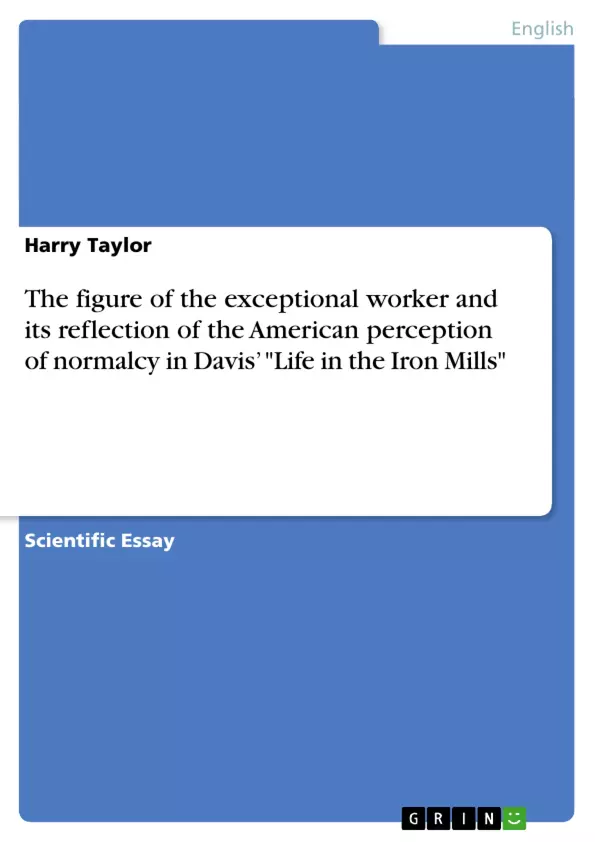This essay examines the role of the ‘exceptional worker’ in Davis’ realist novella Life in the Iron Mills, and what this figure implies regarding contemporary American perceptions of normalcy and class identity.
Inhaltsverzeichnis (Table of Contents)
- Introduction
- An Amoral 'Normalcy'
- Commodification and the 'Exceptional Worker'
- The Aestheticism of the Capitalist Class
- A Misplaced Perception of Reality
- Conclusion
Zielsetzung und Themenschwerpunkte (Objectives and Key Themes)
This essay examines the role of the "exceptional worker" in Davis' realist novella Life in the Iron Mills and its reflection of contemporary American perceptions of normalcy and class identity. It argues that the capitalist class divide propagates a popular amoral "normalcy" characterized by a simultaneous fear of the "human commodity" and a deliberate disacknowledgement of the inhumanity that results from the spiritual "reduction" of the poverty-stricken labor classes. The essay's primary objective is to demonstrate how this amoral normalcy is fostered by the capitalist system, particularly through the commodification of labor and the aestheticising of proletarian conditions. Key themes explored in the text include:- The role of the "exceptional worker" in revealing the amorality of the capitalist system
- The commodification of labor and its impact on the humanity of workers
- The aestheticising of poverty and its role in maintaining the class divide
- The disconnect between the perceptions of reality held by the upper and lower classes
- The inherent "recklessness" of capitalism towards the well-being of the working class
Zusammenfassung der Kapitel (Chapter Summaries)
The essay begins by establishing the concept of an amoral "normalcy" prevalent in 19th-century America, which is characterized by a disregard for the humanity of the working class. The author posits that this disregard is rooted in the commodification of labor, where workers are reduced to mere objects in the production process. This is illustrated through the character of Hugh Wolfe, an impoverished laborer in Davis' novella Life in the Iron Mills, who embodies the "exceptional worker" – a figure who is both exceptional and representative of the struggles of the working class. The essay then examines the way in which the upper classes, through aestheticising the harsh realities of poverty, contribute to the perpetuation of this amoral normalcy. The author argues that this aestheticisation allows them to distance themselves from the realities of commodity production and the human cost of their consumption. This is exemplified through the character of Mitchell, an aesthete who views the working class with a romanticized lens, oblivious to the true suffering and exploitation that lies beneath. Finally, the essay explores the flaws in perception held by the upper classes, which facilitate a shift in the boundaries of normalcy. The author argues that this flawed perception is rooted in an over-aestheticising of reality, which ultimately obscures the true brutality of the capitalist system. This is further exemplified by Mitchell’s mistranslation of a Psalm, demonstrating how even his understanding of the working class’s plight is shrouded in a romanticized, and ultimately, inaccurate, interpretation.Schlüsselwörter (Keywords)
The essay centers on the concepts of class identity, normalcy, commodification, aestheticism, and the "exceptional worker." Key terms include "Life in the Iron Mills," "human commodity," "capitalism," "disacknowledgement," "exploitation," "commodity fetishism," and "proletariat." The essay draws on the works of Karl Marx, particularly his analysis of capitalism and its inherent exploitation of labor, as well as Davis' novella Life in the Iron Mills, which serves as a literary case study for the themes explored.
Final del extracto de 9 páginas
- subir
- Citar trabajo
- Harry Taylor (Autor), 2011, The figure of the exceptional worker and its reflection of the American perception of normalcy in Davis’ "Life in the Iron Mills", Múnich, GRIN Verlag, https://www.grin.com/document/207919
Leer eBook



